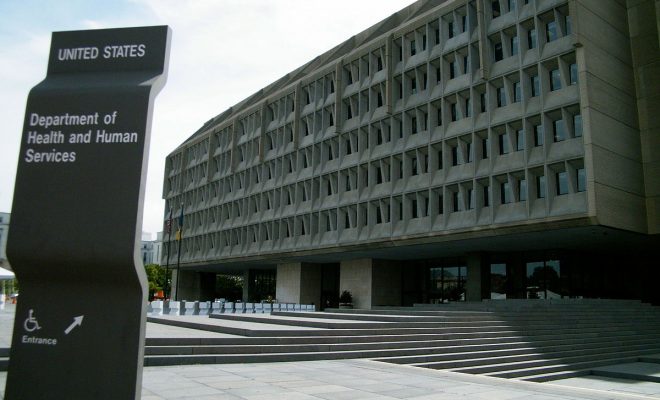 "Department of Health & Human Services" courtesy of Sarah Stierch; License: (CC BY 4.0)
"Department of Health & Human Services" courtesy of Sarah Stierch; License: (CC BY 4.0)
Health & Science
How the American Health Care Act Plans to Dramatically Change Medicaid
As the American Health Care Act works its way through Congress, much of the debate has recently focused on issues like health insurance regulation. While that debate reflects important issues, like protections for people with pre-existing conditions, there is another part that would arguably have even larger consequences: the proposed cuts and changes to Medicaid. The AHCA would fundamentally change the funding structure for the safety net program and could have wide ranging effects on millions of Americans who rely on Medicaid for their health care. Read on for an overview of what’s in store for the program that provides insurance to nearly 20 percent of the country.
Who is Affected
Medicaid is the largest health insurance program in the country, which combined with the related Child Health Insurance Program (CHIP), covered nearly 75 million people as of February. Medicaid covers a diverse group of people including low-income individuals and families, people with disabilities, and the elderly.
The video below explores what the Medicaid program is and how it is paid for:
To understand the scope of the proposed changes to Medicaid in the American Health Care Act, it’s important to look at how the bill it’s intended to repeal and replace–the Affordable Care Act, or Obamacare–changed health insurance coverage in the first place. Generally speaking, the Affordable Care Act sought to increase insurance coverage by expanding the Medicaid program–through both increasing outreach and eligibility–while also creating regulated insurance marketplaces and providing subsidies to make health insurance more affordable.
The Medicaid expansion was directed at the lowest income Americans, specifically, people living below 138 percent of the federal poverty level, while insurance subsidies targeted those who were slightly better off but would still have difficulty paying for health insurance, namely those with incomes below 400 percent of the federal poverty level. Regulations also ensured that individuals could buy insurance on public exchanges and that prices couldn’t vary much according to an individual’s characteristics like age, sex, or health status, which was another way to expand coverage to those who were either priced out of the market or denied insurance outright.
While several components of the ACA sought to lower the rate of uninsured Americans, the Medicaid expansion played the largest role in achieving that goal. The AHCA includes important changes for insurance subsidies and regulation–the proposed cuts and changes to Medicaid are considerably larger. The Congressional Budget Office analyzed the effects of the AHCA in March after it was initially introduced and found that overall, the law would reduce the number of people with health insurance by 24 million within 10 years. The biggest chunk of that decrease, 14 million, would come from the proposed changes to Medicaid. While the law would not technically take people’s insurance away from them–states would have to make difficult decisions about enrollment and eligibility–it would amount to a large cut in federal spending on the program. In total, the CBO estimates that the bill would lead to an $839 billion decrease in federal Medicaid spending over the next 10 years.
The AHCA includes two primary changes to Medicaid that would lead to a significant reduction in people enrolled in the program. First, the bill would phase out the ACA’s Medicaid expansion, decreasing the number of people that states would get a high percentage of federal matching funds to cover. Second, it would change the program’s funding model from an open-ended commitment to an amount per enrollee that gradually increases over time.
Ending the Medicaid Expansion
The Affordable Care Act offered states matching funds to insure a large number of people newly eligible for Medicaid. A 2012 Supreme Court decision made the Medicaid expansion optional at the state level, and since then, 31 states and the District of Columbia have chosen to take the federal funds. At first, the government would pay the full cost of insuring these newly eligible enrollees, but over time the government’s share would drop, and by 2020, it would cover 90 percent of the cost of coverage. The matching rate for the enrollees who gained coverage from the expansion is actually higher than the traditional matching rate that states have historically received for those who were already eligible.
The American Health Care Act plans to unwind the Medicaid expansion starting in 2020. While the plan will end up with an estimated 14 million fewer people on Medicaid relative to current law, the AHCA’s passage will not technically take health insurance away from these individuals. Instead, it grandfathers in all newly eligible enrollees who are already in the program by December 31, 2019–allowing states to continue to receive the 90 percent fund matching for those individuals. However, for people who sign up after that point, the funding would drop to regular matching levels. This means that states will likely decide to restrict their program’s eligibility and return to standards that were in place before the Affordable Care Act.
People on Medicaid tend to cycle in and out of the program relatively quickly, which means that even though the AHCA grandfathers in expansion enrollees, coverage numbers are expected to drop fairly quickly after 2020, when states get lower matching rates. The bill would also require people on Medicaid to re-enroll every six months, rather than every year under current law, to maintain their coverage. This requirement could make it easier for people to accidentally have a lapse in their coverage, which could make those who are grandfathered in unable to re-enter the program. Based on how quickly people have cycled out of the program in the past, the Congressional Budget Office estimates that two years after the expansion ends, fewer than a third of those who were grandfathered in will remain on Medicaid. By 2024, fewer than 5 percent will remain. While the federal government won’t technically take people’s insurance away from them, the drop in funding will likely force states to make the difficult decisions surrounding eligibility and enrollment.
It’s worth noting that politics are an important variable here, so estimating coverage changes can be more of an art than a science when the actions of state legislatures are involved. It’s likely that states will react to a decline in federal funding by reducing the number of people eligible for Medicaid benefits. They may even do so preemptively, as they know that their funding will soon be reduced. Generally, the law will sharply reduce federal funding for Medicaid, but changes will be determined at the state level as they start to shoulder more of the costs.
A New Funding Model
In addition to phasing out the Medicaid expansion, the AHCA intends to dramatically change the funding system for Medicaid. Currently, Medicaid operates as an entitlement program, meaning that the federal government has an open-ended commitment to pay for a large share of the program’s costs. This means that if more people enroll in the program, as is often the case during economic downturns, the federal government continues to bear much of the increase in costs. Similarly, if the cost of medical care increases significantly, as it has been for several decades, the federal commitment increases accordingly. The entitlement nature of Medicaid has been a target of Republicans for decades; however, this is the first attempt to restructure the program while Republicans maintain control of all three branches of government.
Under the AHCA’s per capita cap system, states will get a certain amount per person enrolled. Those amounts will vary based on the different groups eligible for Medicaid to avoid giving states an incentive to shift enrollment to lower costs. For example, the system is designed to prevent states from being pressured to drop enrollment for the elderly or disabled because they may cost more than children. Each year, the per capita cap will increase along with the changes in medical care services component of the Consumer Price Index, which tracks inflation. The medical services component is known as CPI-M. The per capita system will make funding responsive to enrollment changes, but if certain Medicaid costs outpace the overall cost growth for medical services, states will need to pay the additional amount. Generally speaking, shifting to a per person allotment will amount to a significant cut in overall Medicaid spending. The Congressional Budget Office anticipates that Medicaid costs will grow by 4.4 percent per year while CPI-M will grow at just 3.7 percent annually over the next 10 years.
Additionally, the amended AHCA allows states to opt for a block grant rather than a per person cap. This would give states a grant based on their Medicaid population and would give them a considerable amount of freedom in terms of how to use that funding. Proponents say that this would allow states to experiment with funds in order to find new ways to keep costs down and deploy spending more effectively. However, critics argue that a block grant could mean states could be forced to cover fewer people or services than under the per capita cap model, and considerably more so than the current law. This is because block grants would not respond to increases in eligibility, for example due to a recession, and like the per capita model, it would not respond to cost increases that result from new or more expensive types of care. States could charge enrollees more for their care and they could cap enrollment, which could mean even those who are eligible may not be able to join the program.
How it would Change Medicaid
To illustrate how different the system would be under a per capita cap, economists at the Kaiser Family Foundation ran the numbers for Medicaid outlays from 2001 to 2011 to see how tying funds to CPI-M would affect spending. The KFF finds that federal spending would have been $195 billion below actual spending during that period, which would amount to a drop of about 7 percent. Importantly, these changes have very different consequences for the costs involved in covering the different eligible groups in the Medicaid program. For example, spending tied to CPI-M would have been 6 percent lower than actual spending when it comes to the health care costs for the disabled, but it would have been 15 percent lower for children on the program. In both of these cases, states would have had to shoulder more of the costs, but the difference is considerably larger due to faster growth in child health care costs. There is also a lot of variation between states in terms of what they pay for the average Medicaid enrollee. In fact, spending varies so much per person, that 13 states would have actually seen an increase or no change in their overall funding if it was anchored to CPI-M. However, 37 states and the District of Columbia would have seen their funding drop. And for 26 of those states, the drop relative to existing law would have been larger than 10 percent.
Subsequent amendments to the AHCA–after the initial Congressional Budget Office analysis–increased the per capita spending for the blind, elderly, and disabled to CPI-M plus one percentage point. Those changes amount to an estimated $41 billion in additional spending over the next 10 years, according to revised CBO projections. While $41 billion is a significant increase it may not be in the scope of the overall cuts–instead of reducing Medicaid spending by $880 billion, the amended law is projected to drop spending by $839 billion. While the Kaiser Family Foundation estimates mentioned above are based on CPI-M, and AHCA increases that rate slightly for certain populations, its calculations remain instructive.
Critics of the plan argue that the proposed per capita spending caps would limit states’ ability to respond to changes and could leave them on the hook for a lot of spending if certain costs grow faster than overall medical inflation. And because these caps will effectively result in spending cuts relative to the current law, it will ultimately leave states with less funding while also reducing their responsiveness to cost changes. An example of where this could be a problem is in Medicaid’s role in addressing the opioid epidemic. Many people who joined the program after the Medicaid expansion were previously uninsured and did not have access to addiction treatment. Moreover, the entitlement nature of the program allowed the program to respond to costs related to the epidemic. This is important given the program’s role in treatment–in total, Medicaid and CHIP, the related health insurance program for children, cover thirty percent of the U.S. population dealing with opioid addiction.
Conclusion
The American Health Care Act includes a number of adjustments to the current health care system, but the most wide-ranging might be the proposed cuts and changes to the Medicaid program. President Obama’s health law led to a large increase in Medicaid enrollment and the AHCA would roll much of that back while going even further to change the funding structure of the entire program. Taken together these changes amount to an $839 billion spending cut over the next 10 years and 14 million fewer people with health insurance.
Advocates of the bill argue that it will rein in Medicaid spending levels to a more sustainable course while granting states the ability to experiment and cut costs. Critics argue that it will dramatically increase the number of people without insurance by reducing federal funding for Medicaid while not offering alternatives to those who can’t afford insurance. As Senate Republicans begin to work on their own version of the health care bill, these wide ranging changes to Medicaid will likely be an important part of the debate.








Comments